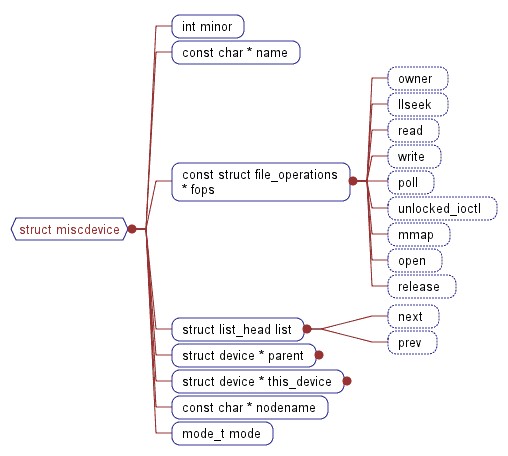标签:
WatchDog Timer驱动
混杂设备
Misc(或miscellaneous)驱动是一些拥有着共同特性的简单字符设备驱动。内核抽象出这些特性而形成一些API(在文件drivers/char/misc.c中实现),以简化这些设备驱动程序的初始化。所有的misc设备被分配同一个主设备号MISC_MAJOR(10),但是每一个可以选择一个单独的次设备号。如果一个字符设备驱动要驱动多个设备,那么它就不应该用misc设备来实现。
通常情况下,一个字符设备都不得不在初始化的过程中进行下面的步骤:
通过alloc_chrdev_region()分配主/次设备号。
使用cdev_init()和cdev_add()来以一个字符设备注册自己。
而一个misc驱动,则可以只用一个调用misc_register()来完成这所有的步骤。
所有的miscdevice设备形成一个链表,对设备访问时,内核根据次设备号查找对应的miscdevice设备,然后调用其file_operations中注册的文件操作方法进行操作。
在Linux内核中,使用struct miscdevice来表示miscdevice。这个结构体的定义为:
struct miscdevice {
int minor;
const char *name;
const struct file_operations *fops;
struct list_head list;
struct device *parent;
struct device *this_device;
const char *nodename;
mode_t mode;
};
minor是这个混杂设备的次设备号,若由系统自动配置,则可以设置为MISC_DYNANIC_MINOR,name是设备名。
每一个misc驱动会自动出现在/sys/class/misc下,而不需要驱动程序作者明确的去做。Linux watchdog timer驱动被实现为misc 驱动,他们被放在drivers/char/watchdog/目录下。Watchdog 驱动也导出了一个标准设备接口到用户空间。这样就可以使符合这个接口的应用程序的实现独立于Watchdog硬件。这个API在内核树中的Documentation/watchdog/watchdog-api.txt文件中有详细的说明。
在Linux驱动中把无法归类的五花八门的设备定义为混杂设备(用miscdevice结构体表述)。miscdevice共享一个主设备号MISC_MAJOR(即10),但次设备号不同。 所有的miscdevice设备形成了一个链表,对设备访问时内核根据次设备号查找对应的miscdevice设备,然后调用其file_operations结构中注册的文件操作接口进行操作。 在内核中用struct miscdevice表示miscdevice设备,然后调用其file_operations结构中注册的文件操作接口进行操作。miscdevice的API实现在drivers/char/misc.c中。

下边是描述这个设备的结构体:
- struct miscdevice {
- int minor;
- const char *name;
- const struct file_operations *fops;
- struct list_head list;
- struct device *parent;
- struct device *this_device;
- };
然后来看看misc子系统的初始化函数:
- static int __init misc_init(void)
- {
- int err;
-
- #ifdef CONFIG_PROC_FS
-
- proc_create("misc", 0, NULL, &misc_proc_fops);
- #endif
-
- misc_class = class_create(THIS_MODULE, "misc");
- err = PTR_ERR(misc_class);
- if (IS_ERR(misc_class))
- goto fail_remove;
-
- err = -EIO;
-
- if (register_chrdev(MISC_MAJOR,"misc",&misc_fops))
- goto fail_printk;
- return 0;
-
- fail_printk:
- printk("unable to get major %d for misc devices/n", MISC_MAJOR);
- class_destroy(misc_class);
- fail_remove:
- remove_proc_entry("misc", NULL);
- return err;
- }
- subsys_initcall(misc_init);
下边是register_chrdev函数的实现:
- int register_chrdev(unsigned int major, const char *name,
- const struct file_operations *fops)
- {
- struct char_device_struct *cd;
- struct cdev *cdev;
- char *s;
- int err = -ENOMEM;
-
- cd = __register_chrdev_region(major, 0, 256, name);
- if (IS_ERR(cd))
- return PTR_ERR(cd);
-
- cdev = cdev_alloc();
- if (!cdev)
- goto out2;
-
- cdev->owner = fops->owner;
- cdev->ops = fops;
-
- kobject_set_name(&cdev->kobj, "%s", name);
- for (s = strchr(kobject_name(&cdev->kobj),‘/‘); s; s = strchr(s, ‘/‘))
- *s = ‘!‘;
-
- err = cdev_add(cdev, MKDEV(cd->major, 0), 256);
- if (err)
- goto out;
-
- cd->cdev = cdev;
-
- return major ? 0 : cd->major;
- out:
- kobject_put(&cdev->kobj);
- out2:
- kfree(__unregister_chrdev_region(cd->major, 0, 256));
- return err;
- }
来看看这个设备的操作函数的集合:
- static const struct file_operations misc_fops = {
- .owner = THIS_MODULE,
- .open = misc_open,
- };
可以看到这里只有一个打开函数,用户打开miscdevice设备是通过主设备号对应的打开函数,在这个函数中找到次设备号对应的相应的具体设备的open函数。它的实现如下:
- static int misc_open(struct inode * inode, struct file * file)
- {
- int minor = iminor(inode);
- struct miscdevice *c;
- int err = -ENODEV;
- const struct file_operations *old_fops, *new_fops = NULL;
-
- lock_kernel();
- mutex_lock(&misc_mtx);
-
- list_for_each_entry(c, &misc_list, list) {
- if (c->minor == minor) {
- new_fops = fops_get(c->fops);
- break;
- }
- }
-
- if (!new_fops) {
- mutex_unlock(&misc_mtx);
-
- request_module("char-major-%d-%d", MISC_MAJOR, minor);
- mutex_lock(&misc_mtx);
-
- list_for_each_entry(c, &misc_list, list) {
- if (c->minor == minor) {
- new_fops = fops_get(c->fops);
- break;
- }
- }
- if (!new_fops)
- goto fail;
- }
-
- err = 0;
-
- old_fops = file->f_op;
-
- file->f_op = new_fops;
- if (file->f_op->open) {
-
- err=file->f_op->open(inode,file);
- if (err) {
- fops_put(file->f_op);
- file->f_op = fops_get(old_fops);
- }
- }
- fops_put(old_fops);
- fail:
- mutex_unlock(&misc_mtx);
- unlock_kernel();
- return err;
- }
再来看看misc子系统对外提供的两个重要的API,misc_register,misc_deregister:
- int misc_register(struct miscdevice * misc)
- {
- struct miscdevice *c;
- dev_t dev;
- int err = 0;
-
- INIT_LIST_HEAD(&misc->list);
- mutex_lock(&misc_mtx);
-
- list_for_each_entry(c, &misc_list, list) {
- if (c->minor == misc->minor) {
- mutex_unlock(&misc_mtx);
- return -EBUSY;
- }
- }
-
- if (misc->minor == MISC_DYNAMIC_MINOR) {
-
- *static unsigned char misc_minors[DYNAMIC_MINORS / 8];
- *这里存在一个次设备号的位图,一共64位。下边是遍历每一位,
- *如果这位为0,表示没有被占有,可以使用,为1表示被占用。
- */
- int i = DYNAMIC_MINORS;
- while (--i >= 0)
- if ( (misc_minors[i>>3] & (1 << (i&7))) == 0)
- break;
- if (i<0) {
- mutex_unlock(&misc_mtx);
- return -EBUSY;
- }
-
- misc->minor = i;
- }
-
- if (misc->minor < DYNAMIC_MINORS)
- misc_minors[misc->minor >> 3] |= 1 << (misc->minor & 7);
-
- dev = MKDEV(MISC_MAJOR, misc->minor);
-
- misc->this_device = device_create(misc_class, misc->parent, dev, NULL,
- "%s", misc->name);
- if (IS_ERR(misc->this_device)) {
- err = PTR_ERR(misc->this_device);
- goto out;
- }
-
-
-
- list_add(&misc->list, &misc_list);
- out:
- mutex_unlock(&misc_mtx);
- return err;
- }
这个是miscdevice的卸载函数:
- int misc_deregister(struct miscdevice *misc)
- {
- int i = misc->minor;
-
- if (list_empty(&misc->list))
- return -EINVAL;
-
- mutex_lock(&misc_mtx);
-
- list_del(&misc->list);
-
- device_destroy(misc_class, MKDEV(MISC_MAJOR, misc->minor));
- if (i < DYNAMIC_MINORS && i>0) {
-
- misc_minors[i>>3] &= ~(1 << (misc->minor & 7));
- }
- mutex_unlock(&misc_mtx);
- return 0;
- }
总结一下miscdevice驱动的注册和卸载流程:
misc_register:
匹配次设备号->找到一个没有占用的次设备号(如果需要动态分配的话)->计算设号->创建设备文-
miscdevice结构体添加到misc_list链表中。
misc_deregister:
从mist_list中删除miscdevice->删除设备文件->位图位清零。
misc设备
标签:
原文地址:http://www.cnblogs.com/reality-soul/p/4709008.html
